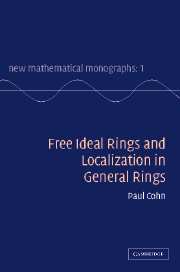Book contents
- Frontmatter
- Contents
- Preface
- Note to the reader
- Terminology, notation and conventions used
- List of special notation
- 0 Generalities on rings and modules
- 1 Principal ideal domains
- 2 Firs, semifirs and the weak algorithm
- 3 Factorization in semifirs
- 4 Rings with a distributive factor lattice
- 5 Modules over firs and semifirs
- 6 Centralizers and subalgebras
- 7 Skew fields of fractions
- Appendix
- Bibliography and author index
- Subject Index
Appendix
Published online by Cambridge University Press: 22 August 2009
- Frontmatter
- Contents
- Preface
- Note to the reader
- Terminology, notation and conventions used
- List of special notation
- 0 Generalities on rings and modules
- 1 Principal ideal domains
- 2 Firs, semifirs and the weak algorithm
- 3 Factorization in semifirs
- 4 Rings with a distributive factor lattice
- 5 Modules over firs and semifirs
- 6 Centralizers and subalgebras
- 7 Skew fields of fractions
- Appendix
- Bibliography and author index
- Subject Index
Summary
This appendix gives a brief summary of facts needed from lattice theory, homological algebra and logic, with references to proofs or sometimes the proofs themselves. In each section some reference books are listed, with an abbreviation which is used in quoting them in the appendix.
Lattice theory
LT: G. Birkhoff, Lattice Theory, 3rd Edition. Amer. Math. Soc. Providence RI 1967.
BA: P. M. Cohn, Basic Algebra, Groups, Rings and Fields. Springer, London 2002.
FA: P. M. Cohn, Further Algebra and Applications. Springer, London 2003.
UA: P. M. Cohn, Universal Algebra, 2nd Edition. D. Reidel, Dordrecht 1981.
(i) We recall that a lattice is a partially ordered set in which any pair of elements a, b has a supremum (i.e. least upper bound, briefly: sup), also called join and written a ∨ b, and an infimum (i.e. greatest lower bound, briefly: inf), also called meet and written a ∨ b. It follows that in a lattice L every finite non-empty subset has a sup and an inf; if every subset has a sup and an inf, L is said to be complete. A partially ordered set that is a lattice (with respect to the partial ordering) is said to be lattice-ordered. It is possible to define lattices as algebras with two binary operations ∨,∧ satisfying certain identities, so that lattices form a variety of algebras (LT, p. 9, UA, p. 63 or BA, Section 3.1).
- Type
- Chapter
- Information
- Free Ideal Rings and Localization in General Rings , pp. 519 - 539Publisher: Cambridge University PressPrint publication year: 2006



